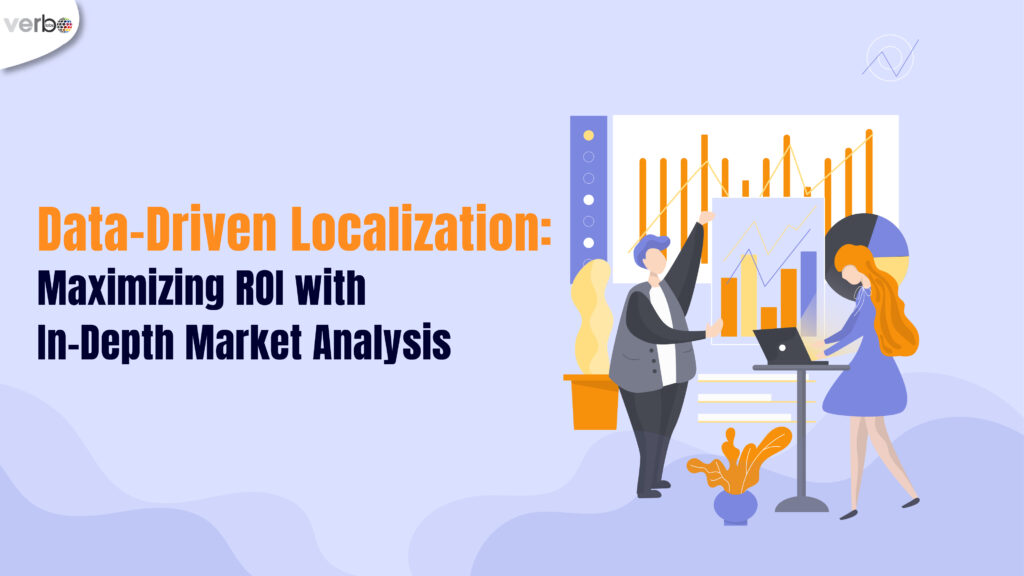In globalized business, reaching new markets is a key strategy for growth. However, the one-size-fits-all approach is outdated, and businesses are increasingly turning to data-driven localization to tailor their products and services to specific markets. This not only enhances customer experience but also maximizes return on investment (ROI). In this blog post, we will dive into the concept of data-driven localization, exploring its importance, benefits, and providing real-world examples to illustrate its impact.
Understanding Data-Driven Localization:
Data-driven localization involves using data analytics and market insights to customize products, services, and marketing strategies to meet the unique needs and preferences of specific target audiences in different regions. This approach goes beyond language translation; it considers cultural nuances, consumer behaviors, and local market trends.
Importance of Data-Driven Language Localization
In the rapidly evolving landscape of global business, the strategic implementation of data-driven localization emerges as a crucial element for success. The ability to understand and adapt to diverse cultures, markets, and regulatory landscapes is imperative for businesses aiming to thrive on an international scale. Through this lens, let’s delve into examples that underscore the pivotal role of data-driven localization in various aspects of business strategy.
1. Cultural Relevance:
The first pillar of data-driven localization lies in achieving cultural relevance, a factor that significantly influences consumer engagement. A prime illustration of this is evident in the success of Coca-Cola’s “Share a Coke” Campaign.
Coca-Cola’s “Share a Coke” Campaign:
In an innovative marketing move, Coca-Cola replaced its iconic logo with popular names in different regions, creating a personalized touch for consumers. This data-driven strategy showcased a profound understanding of cultural nuances, encouraging customers to share custom-labeled bottles. The result? Increased consumer engagement, amplified sales, and a potent demonstration of the impact when marketing resonates culturally.
2. Market Understanding:
Market understanding is a cornerstone of effective data-driven localization, requiring businesses to discern and cater to unique preferences in diverse regions. A stellar example of this principle is found in Airbnb’s Localization Strategy.
Airbnb’s Localization Strategy:
Airbnb’s success on a global scale is underpinned by its adept analysis of local markets. Through robust data analysis, Airbnb identifies features that resonate with users in different regions. Notably, the platform recognized the emphasis on high-quality photos by users in Asia. This data-driven insight led Airbnb to prioritize and enhance photo quality in that market, contributing significantly to its global triumph.
3. Adaptation to Local Regulations:
Navigating the labyrinth of local regulations is a challenge for businesses expanding internationally. Here, the role of data-driven insights becomes paramount, as exemplified by Uber’s Compliance with Local Laws.
Uber’s Compliance with Local Laws:
Uber, in its global expansion journey, encountered diverse regulatory landscapes. Through a data-driven approach, the company proactively understood and complied with local regulations. This strategic move not only ensured legal adherence but also bolstered Uber’s reputation in various regions, showcasing the power of leveraging data for successful adaptation.
Benefits of Data-Driven Localization:
Moving beyond challenges, data-driven localization offers a spectrum of benefits that directly influence customer experience, market penetration, and marketing spend optimization. Let’s explore these benefits through concrete examples.
1. Improved Customer Experience:
Enhancing customer experience through tailored offerings is a cornerstone of successful global brands. A prime illustration of this is found in McDonald’s Localized Menus.
McDonald’s Localized Menus:
McDonald’s adeptly tailors its menu to suit local tastes, as evidenced in India where a significant vegetarian population prompted the introduction of diverse vegetarian options. This strategic localization not only increases customer satisfaction but also fosters brand loyalty by catering to regional preferences.
2. Increased Market Penetration:
Achieving substantial market penetration hinges on resonating with local audiences. A shining example of this principle is visible in Nike’s Regional Marketing Campaigns.
Nike’s Regional Marketing Campaigns:
Nike tailors its marketing campaigns to resonate with local audiences, as seen in China where collaborations with local influencers and artists result in culturally relevant content. This targeted approach not only boosts brand visibility but also establishes a profound rapport within the local market, contributing to increased market penetration.
3. Optimized Marketing Spend:
Efficient allocation of marketing resources is a critical aspect of data-driven localization. An exemplar of this efficiency is found in Google’s Data-Driven Ad Targeting.
Google’s Data-Driven Ad Targeting:
Google utilizes data analytics to target ads based on user preferences and behaviors, ensuring that marketing spend is optimized for maximum impact. By localizing ad content and precisely targeting demographics, Google achieves higher conversion rates and a superior return on investment (ROI), showcasing the strategic advantage of leveraging data for marketing efficiency.
Implementing Data-Driven Localization:
- Data Collection and Analysis: Businesses should collect and analyze data on customer preferences, behaviors, and cultural nuances in each target market. This can include surveys, social media analytics, and market research.
- Cross-Functional Collaboration: Collaboration between marketing, sales, product development, and data analytics teams is crucial. A cross-functional approach ensures that all aspects of the business are aligned with the localization strategy.
- Continuous Iteration: Localization is an ongoing process. Regularly revisit and update strategies based on evolving market trends, customer feedback, and new data insights.
Conclusion
Data-driven language localization is a powerful tool for businesses seeking to expand their global footprint. By leveraging data analytics, understanding local cultures, and adapting strategies to meet specific market needs, companies can maximize ROI and build stronger connections with customers around the world. The examples provided demonstrate that successful data-driven localization is not just about language translation; it’s about creating a meaningful and personalized experience for each target audience. As the business landscape continues to evolve, embracing data-driven localization will be essential for staying competitive and ensuring sustainable growth.



